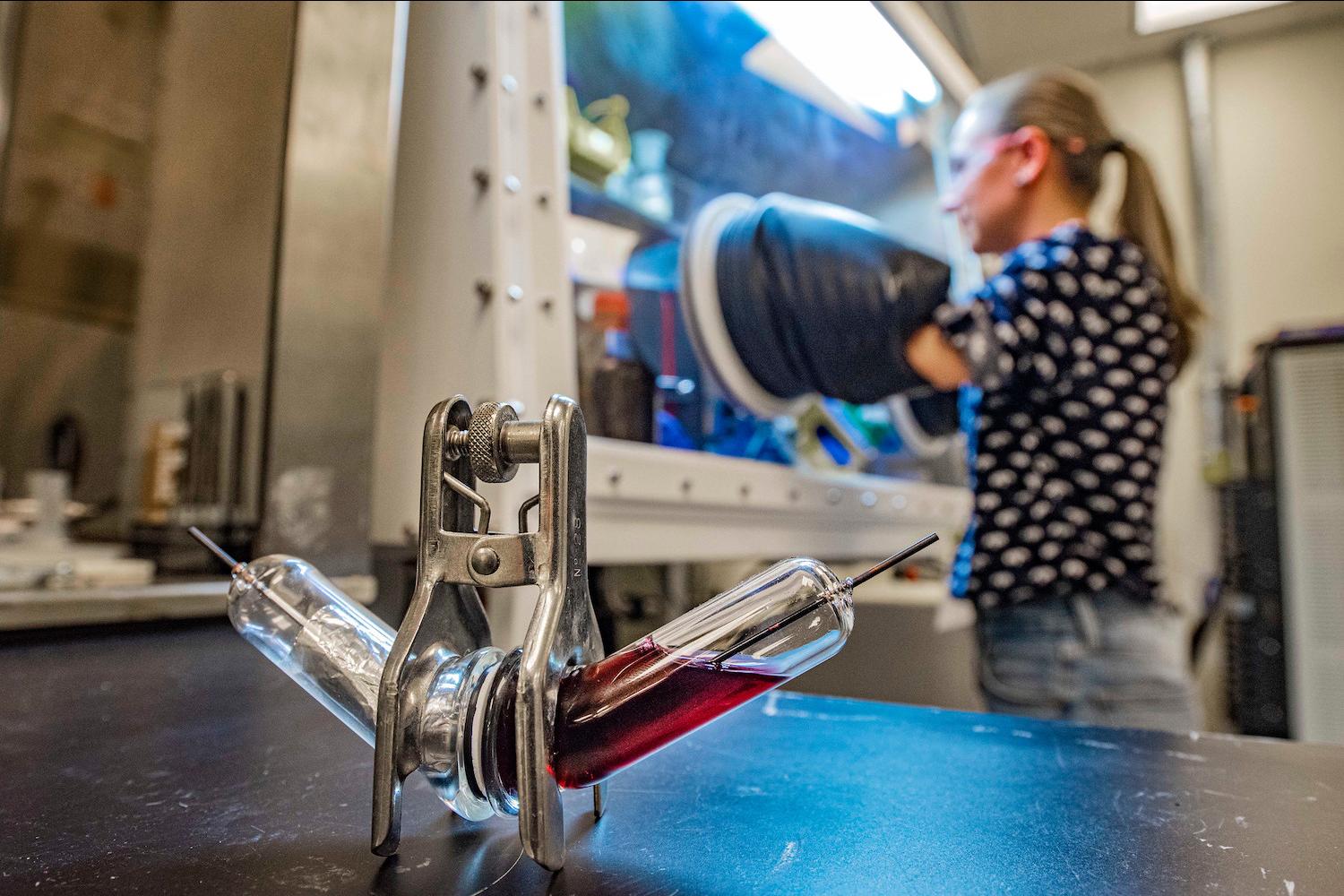
Postdoctoral researcher Martha Gross works in an argon glove box with a test battery cell illustrating a lab-scale sodium iodide battery.
New energy storage technologies are on the horizon, promising to solve the largest barrier to renewable energy — short term variability and seasonal imbalance, aka the need for power when the wind isn’t blowing and the sun isn’t shining. Long-term energy storage would ideally store and deliver days’ — or even weeks’ — worth of electricity, rather than just a few hours. For example, storing solar power from August’s sunny days until the overcast tinge of January. But full commercialization of these long-duration technologies is years away, even as the need for energy storage continues to grow rapidly.
Even a few hours of stored electricity can make a significant difference in terms of grid resilience and other bottom-line benefits. Before long-term storage is made widely available, facility managers can — and should — take advantage of energy storage in the form of rechargeable batteries available today.
The growing need for energy storage
Climate change, renewable energy, and the electrification movement are the intertwined drivers behind the surging interest in battery energy storage systems (BESS).
Wind and solar power help resolve the climate crisis by replacing fossil energy with zero-emission electricity, but these resources are, by nature, intrinsically variable. BESS can smooth out the gaps between this newly variable supply and traditional variable demand.
Much of the media conversation around BESS has focused on once-upon-a-time startups like the electric vehicle leader Tesla Motors and dozens of other emerging startups among the many technologies. In reality, automakers — including Tesla — have been relying heavily on legacy engineering and technology leaders to supply lithium-ion batteries and related electrification infrastructure.
Global consulting, engineering and construction firm Black & Veatch was very much involved in the initial build-out of Tesla’s Supercharger vehicle charging station network. The partnership, launched in 2014, provided Black & Veatch with an opportunity to demonstrate its ability to scale up deployment of large-scale battery energy storage systems.
Black & Veatch has also been applying its expertise in BESS to the fields of distributed generation and microgrids. Microgrids are designed to supply electricity to a limited area, such as small communities, military facilities, academic campuses and corporate parks. They incorporate energy storage to deliver power when wind or solar are insufficient or not available.
Battery energy storage is filling the gaps
Frank Jakob, technology manager for energy storage at Black & Veatch, notes that a dramatic, ongoing drop in the cost of lithium-ion batteries has made energy storage a mainstream, bottom-line option for facility managers. The same economics driving batteries for electric vehicles is enabling stationary energy storage for electricity.
Jakob says lithium-ion energy storage passed the cost threshold back in 2015. “Today, it’s now an economical substitute for grid power, for single-cycle gas turbines, and for demand-response elements such as reducing peak load,” he told TriplePundit. “You no longer have to pull down your peak load — you can use a battery to sustain operations.”
Part of the force behind the drop in cost is the scale-up of the battery supply chain, for which automakers can take much of the credit. Currently, the auto industry accounts for about 90 percent of the market for lithium-ion battery cells.
Taking battery energy storage to the next level
Despite a vigorous conversation around introducing more BESS into the grid, energy storage in the power sector currently accounts for only 5 percent of the battery cell market, with the remaining 5 percent taken up by forklifts and mobile electronic gear.
Leslie Ponder, technology portfolio director for global distributed energy at Black & Veatch, notes that market forces can make the case for utilities to adopt more BESS. Energy storage helps utilities add more wind and solar generation to the grid without sacrificing power quality or reliability. Some utilities are also turning to microgrids with BESS as a means of isolating and maintaining critical loads during periods of high fire hazard as long-distance overhead distribution power lines are deenergized to reduce fire risk.
Still, market incentives can vary from one region to another, depending on the cost of energy, Ponder noted. Businesses can use BESS to reduce their costs during peak demand periods. Under a scenario in which energy costs are relatively high, an investment in BESS can yield significant benefits.
BESS can also yield significant benefits in areas where energy costs are relatively low. Energy storage can provide resiliency from grid outages. It can also enable energy users to mitigate capacity hurdles that restrict how much power they can draw from the grid at certain times. Additional usage for electric vehicle charging, for example, can be a key issue for fleet managers seeking to electrify their vehicles or provide workplace charging for their employees. That consideration applies to government fleets, those of other institutions, as well as commercial fleets.
Beyond market forces
Overall, the rising cost of natural gas has motivated utilities and energy users to take a closer look at BESS. Even before the current gas price spike, utilities were beginning to develop renewable energy paired with BESS to reduce or eliminate the need to build new gas power plants. Customer sited rooftop solar systems and on-site wind turbines are also becoming commonplace. Meanwhile, the installed cost of wind and solar continues to drop, along with BESS.
A number of different state-based energy policies provide utilities in some areas incentive to move more aggressively toward BESS, Ponder said. “There are different markets in the U.S., different areas of the country, with mandates or incentives that cause battery energy storage solutions to be considered for work as well as being constructed,” she explained. “For example, California and New York require utilities to look at BESS or other non-wire alternatives as options to solve grid problems. States also have incentives around resiliency and reliability needs that are driving the increase in battery energy storage.”
Also helping to drive the market is last year’s rule change by the Federal Energy Regulatory Commission, which enables owners of BES systems and other distributed energy resources to aggregate and compete in wholesale electricity markets.
Beyond lithium-ion storage
From a facility manager point of view, the case for BESS is strong. On-site energy storage provides for more control over the power supply and enhances the ability to electrify operations. It can also provide facility managers with opportunities to explore new revenue streams for these new technologies and become energy sellers as well as consumers.
As a means of reducing reliance on fossil energy, BESS can also relieve corporations from the policy uncertainty and regulatory stress involved in fossil energy infrastructure, including the controversial area of oil and gas pipeline construction.
In past years, safety concerns may have caused some hesitation around lithium-ion-based BESS. However, technology improvements in recent years have mitigated this issue. Black & Veatch currently recommends the lithium iron phosphate formula, for example, which is considered even more safe than other lithium-ion batteries.
Jakob also points out that system improvements, such as cooling plates, enable BESS systems to operate more efficiently at an optimal temperature, while new predictive sensors and other monitoring equipment enable operators to spot and fix potential problems before there is any impact on the system.
Lithium-ion-based BESS systems still cost more upfront than lead-acid batteries. However, they can easily make up the difference over time because they last about 10 times longer.
Still, the increase in climate-related disasters and the urgent need for additional resiliency are driving interest in technology that can outperform BESS on duration.
Black & Veatch has been tracking the development of long-duration energy storage systems, based on a variety of different technologies. Some are based on new chemistries that can last 10 hours or more, such as flow batteries. Others are based on gravity, temperature, or pressure.
When long-duration technology does hit the market, developers may still need to convince corporate and facility energy planners of their value. Jakob notes that under current conditions, most electricity users do not “value the 10th hour of storage any more than the first hour,” and resign themselves to the current state of lithium-ion-based BESS.
Energy planners will have many more opportunities to adopt new storage systems in the coming years, considering the Joe Biden administration’s focus on clean technology.
The new bipartisan infrastructure bill is already signed into law, along with provisions for significant new investments in energy storage and renewable energy technology. The companion bill, Build Back Better, has already passed the House of Representatives. If it squeaks through the Senate, it will also help accelerate the clean energy transition in the U.S.
Energy users who plan ahead for BESS and other new energy storage opportunities will be all the more prepared to harden their operations against the impacts of climate change, including price spikes and other power system disruptions.
This article series is sponsored by Black & Veatch and produced by the TriplePundit editorial team.
Image courtesy of Sandia Labs via Flickr

TriplePundit editors offer news and insights on sustainable business.














